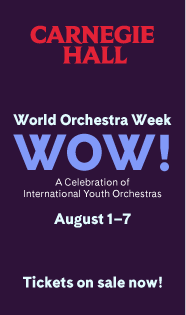Parlando speaks volumes with music for strings
If classical music doesn’t speak to you, maybe what you need is the performers speaking to you before they play.
That’s the idea behind the chamber orchestra Parlando, the new enterprise of Ian Niederhoffer, the 25-year-old Yale graduate and emerging conductor who introduced each selection, then led well-played performances of music by Webern, Ted Hearne, and Shostakovich at Merkin Hall Sunday afternoon. The last composer’s Piano Concerto No. 1 got an extra lift from dazzling solos by pianist Maxim Lando and trumpeter David Krauss.
The program’s title, “Dialogues,” might do for practically any concert, but the conductor explained that each piece represented a specific kind of dialogue, whether between people, musical works, or soloists in a concerto—a topic perhaps more of interest to academics than to audiences.
The orchestra borrowed its own name from the Italian word for “speaking,” which in music denotes phrases whose rhythm and inflection mimic speech. At least since the days when Harvard man Leonard Bernstein had the whole family gathered around the television set for his Young People’s Concerts, the idea of mixing musical performance with some kind of talking program notes—the goal being, as Sunday’s printed program put it, “to remove the barriers to entry to classical music concerts”—has attracted musicians with a flair for public speaking (a very select group, it must be noted).
Sunday’s audience at Merkin, which appeared to include many friends and relatives of the performers, didn’t seem to suffer much from “barriers to entry,” although it did skew younger than, say, audiences at the Chamber Music Society of Lincoln Center. (It tells you something about who was expected to attend that, on a five-point scale of listener difficulty, the program gave the piece by Webern a score of one, meaning “the most comfortable, conventional.”)
As a speaker, Niederhoffer isn’t quite in Bernstein territory yet. He verbally imparted information about the pieces in the earnest manner of a graduate teaching assistant. But when he turned to his band and let the music do the talking, he proved a confident and expressive communicator.
Under his baton-less direction, Webern’s early Langsamer Satz blossomed with the post-Straussian romanticism that earned it its easy-listening score. The original string-quartet version was expanded to a couple of dozen string players, with three double basses rumbling in support, adding lushness to lushness. Every phrase was sensitively shaped, needing only a bit more sliding portamento to complete the atmosphere of turn-of-the-century decadence.
In his remarks, the conductor told the story of the composer’s walk in the woods with a lady friend, which inspired both this piece and a marriage proposal. But he neglected to say what the piece’s title meant. A person unfamiliar with German might guess it was the name of the place where young Webern popped the question, but no, it translates simply as “slow movement.”
Explaining the 2012 piece Law of Mosaics for string orchestra by the Chicago-born, Los Angeles-based composer Ted Hearne, Niederhoffer didn’t have to venture far beyond the titles of the work’s six movements, which were mini-program notes in themselves (Movement 3: “Climactic moments from Adagio for Strings and The Four Seasons slowed down and layered on top of one another”).
True to its title, “Excerpts from the middle of something” consisted mainly of bursts of activity separated by extremely long rests, which Niederhoffer discreetly counted out with his baton. “Palindrome for Andrew Norman” alluded to a piece by that composer that was commissioned along with this one for an album by the chamber orchestra A Far Cry; other quotations extended as far back as a Bach Brandenburg Concerto, as polytonal, motoric passages alternated with slow chords under a high violin tremolo.
The third movement was just as advertised, stratospheric Barber violins over a growl of Vivaldi violas and cellos, producing a tasty polytonal stew. Niederhoffer called the brief movement “Beats” a punk-rock piece, but its screaming tremolos and barking syncopations in the bass put one more in mind of heavy metal. Watching the players execute this complex, violent music was a reminder of why no recording or video can ever duplicate the impact of live performance.
As advertised, the brief, wistful fifth movement delivered “Climactic moments from movement three, three times as slow as before.” In conclusion, “The warp and the woof” began with harsh chords and long silences, from which a threnody-like melody for muted strings slowly emerged.
Despite its persistent dissonances and enigmas, Hearne’s piece earned a mere three difficulty points in the program. Perhaps that was allowing for the committed, energetic performance Niederhoffer drew from his players.
Looking at the Shostakovich concerto soloists onstage, one wondered if they had conspired to project their odd-couple persona: trumpeter Krauss sitting impassive, bespectacled, silver-haired, dark-suited, like a bank loan officer with a horn; the young pianist Lando a whirlwind on the bench, shaggy and nervous in a flowing silver satin shirt.
In any case, both deftly handled whatever this composer threw at them, be it bucketfuls of notes (especially in the scintillating piano part) or long lyrical lines (including some exquisite trumpet pianissimos). Leaning in so close his nose nearly touched the keys, Lando fired percussive volley after volley, especially in the manic finale. Soloists and orchestra excelled in the long Lento middle movement, which was rich in expressive rubato without ever losing the thread of its gentle valse-triste beat.
At the work’s end, orchestra and soloists responded to the storm of applause with what was literally an encore. They repeated the giddy last pages of the finale, with just one difference: instead of the forearm smash called for in the score, this time the lean-in pianist did a forehead smash.
For the record, Shostakovich’s concerto scored one measly listener-difficulty point in the program. Clearly this system also needs negative scores, to indicate not only no difficulty in listening, but sheer delight.
Ian Niederhoffer conducts Parlando in “Cinema vs. the Concert Hall” February 27, 2022 at Merkin Hall. kaufmanmusiccenter.org.

